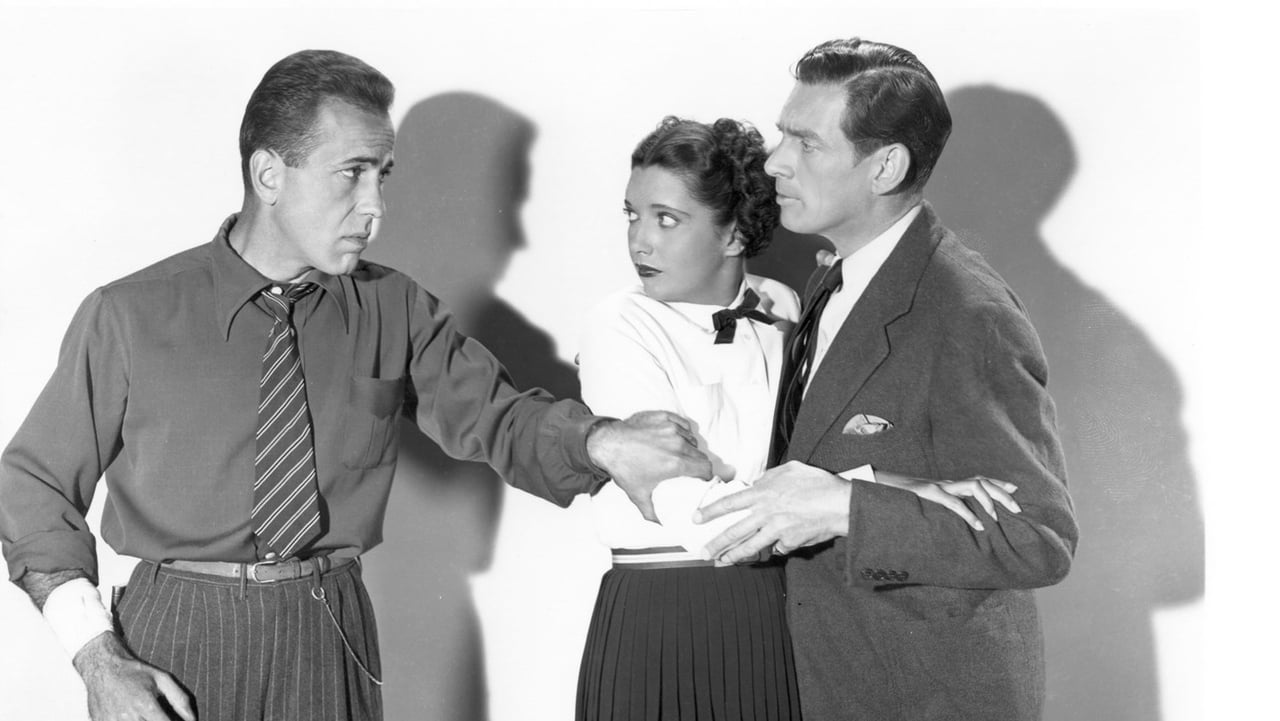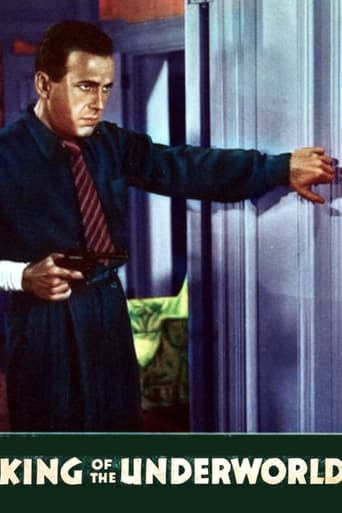

Quickly Made Gangster Movie with Kay Francis vs Humphrey Bogart Central to the Thin Plot. Bogey is a Stereotypical Bully with a Moronic Sense of Humor and an Ego to Match His Hero "Napoleon". Kay Francis, on the other hand is Anything but Stereotypical for the Era. She Plays a Strong Female Doctor having to use Her Wits and Wiles to Save Her Career and Her Determination and Intelligence is a Refreshing Role for Her Gender in the 1930's. She is Totally Believable in the Part and Matching Her is Bogey's Goofy Gangster and somehow the Bogart Character comes across as a Likable, Brainless Thug like something in a Cartoon.Overall, some Side Characters like Kay's Mother tend to Grate the Nerves and a couple of Bogart's Gang are very Dated Stock Gangsters. The Film is Entertaining and Enjoyable while Not in the same League as the Best WB Crime Films of the Thirties.It's a Short, Fast Paced and Compact Movie with enough Playful Panache to Pass as a Lighter than Usual Look at some of the Clichés of the Genre.
... View MoreThis movie is a cinematic collage of gangster clichés. The writing is grade z and the plot and story are constructed without care or logic. It a messy pastiche of stereotypical gangsters (think of Bugs Bunny cartoons) and silly supporting characters (the lady doctor and the writer). There are much better Bogart films out there. In fact, Bogart looks like he slept through this performance. He puts very little effort into this character. I think the directorial advice he received was something like "He's a bad guy. Act bad". This guy is the era's equivalent of Darth Vader; obvious, evil and the anti-hero. Don't waste your time with this one.
... View MoreI wonder if the screenwriter for this film had somebody in mind as a model for the criminal Humphrey Bogart plays. In the 1920s and 1930s there was a major war between Joe Masseria and Salvator Marranzano for control of New York's criminal underworld. Marranzano, on the surface, seemed more modern to the younger crowd of gangsters like Luciano, Costello, Siegel, Lansky, and Lepke, and they helped him get rid of the "Mustache Petes" or old style gangsters supporting Masseria (and eventually Masseria himself). But they found that rather than restructuring the criminal world into a model corporate structure, Marranzano had delusions of grandeur. He was intoxicated by the image and memory of Gaius Julius Caesar, and intended to make himself the Caesar of the New York Underworld. Eventually "Caesar" Marranzano was bumped off by the disgruntled young Turks who did not plan for him to be a "Capo di Capo".Interestingly enough he was stabbed to death in his office - one wonders if Luciano and the others purposely copied Caesar's demise in the forum. In this remake of an early Paul Muni film, DR. SOCRATES, Kay Francis is a female doctor who discovers that her late husband was tied to a powerful mobster (Bogart) and got killed helping him with some medical attention for one of his gang. The police and A.D.A. (Pierre Watkins) arrest and try Francis on really weak grounds as an accomplice, but the jury is deadlocked and she is released while the A.D.A. decides whether or not to retry her. Francis is determined to prove her innocence by catching Bogart.Humphrey Bogart played many gangsters in the 1930s, and most of them were quite dangerous types, like Duke Mantee in THE PETRIFIED FOREST or Baby Face Martin in DEAD END. But his gangster boss here is ridiculous. The reason is that the screenwriter created a personality point about this gangster that is never pursued properly in the film. Bogart is enamored by the career of Napoleon Bonaparte, and keeps mentioning this. Never once in the course of the film, outside an occasional reference to say Waterloo or some incident like that, do we see Bogie trying to use Napoleons aphorisms and strategies in his crimes! For example, Bonaparte once dismissed military brilliance and said something to the effect that he preferred "lucky" generals to brilliant ones. He realized that a brilliant general could get so hung up about his own brilliant schemes that he could blow a major battle, whereas a "lucky" general looks quickly at a situation and grabs the initiative. Bogart does not show any inclination to follow that particular piece of wisdom, and does not even mention it.Bogart also is never shown using any of the strategies that made Marengo or Austerlitz or Jena victories that rang down through the last two centuries in his robbery schemes or crimes. For a man who supposedly admires a great figure he doesn't seem willing to learn from him!In the plot Francis hides in a small town and Bogart shows up there to rescue two of his men from the local police (actually similar to an incident involving gangster John Dillinger). Bogart has also picked up a traveling writer (James Stephenson) who he realizes can ghost write Bogies criminal memoirs. Stephenson is arrested in the incident, but he is released into Francis' custody (she is now a doctor in the town), and subsequently kidnapped by Bogie (not quite like the unfortunate Duc de Enghien). Soon Francis is in pursuit, and notes Bogies health as a potential key to undermining his control of her fate and Stephenson's. It involves giving him a peculiar drug that has to be also given to all his men at the same time to disable them all. This part of the script is absolutely unbelievable as Bogie's gangster does not accept the simple solution of selecting one of his men as a guinea pig to test the drug on (Francis manages to browbeat him into taking the drug!).There are elements of other, better films in KING OF THE UNDERWORLD. Most notable is James Stephenson's writer/hobo who resembles Leslie Howard's in THE PETRIFIED FOREST. The acting is pretty good (best are the scenes involving the local bigwig doctor who resents the arrival of Francis in the small town, and starts making problems for her). Stephenson was a fine young actor, whose best role (the troubled barrister defending Bette Davis' "Leslie Crosby" in THE LETTER) was yet to come, and his death in the early 1940s was a true loss to movies. Francis does nicely in her role, even if her victory over Bogie is asinine. Bogie is good - wish I could say the same for his character or the script.
... View More"King of the Underworld" paces at a machine gun clip, with Humphrey Bogart as Joe Gurney, a crime boss who quotes Napoleon and fancies himself as the last of the public enemies. When doctors Niles and Carol Nelson (John Eldredge and Kay Francis) perform a difficult surgery and save one of his men, Gurney insinuates himself into their lives with money and power. Niles can't help himself, and welcomes the added income to support his gambling habit. Carol feels something amiss, but it's only when Niles is killed in a gang shootout with the police that she comes to understand how entangled her situation has become.This isn't one of Bogey's better gangster films, certainly not on a par with "The Roaring Twenties" or "High Sierra". His characterization of mobster Gurney felt somewhat forced and uncomfortable. He does however take peculiar pride in reaching the top of his chosen profession, taking some delight in author Bill Stevens' (James Stephenson) suggestion for an autobiography - "Joe Gurney - The Napoleon of Crime".For an interesting scene that shows how far we've come from the movie's 1939 year of release, consider how amazed the shopkeeper was to receive a hundred dollar bill from Mrs. Nelson, the first one he'd seen in at least six months! Ultimately, Mrs. Nelson turns the tables on Gurney's gang through a clever ruse using a chemical solution to temporarily blind them, on the pretense that they could actually go blind from an infection caused by a gunshot suffered by Gurney. But she couldn't have done so if she didn't make her way back to Gurney's hideout. When brought there the first time to treat Gurney she was blindfolded, but apparently wasn't blindfolded on the way back - not too clever for the Napoleon of Crime!
... View More